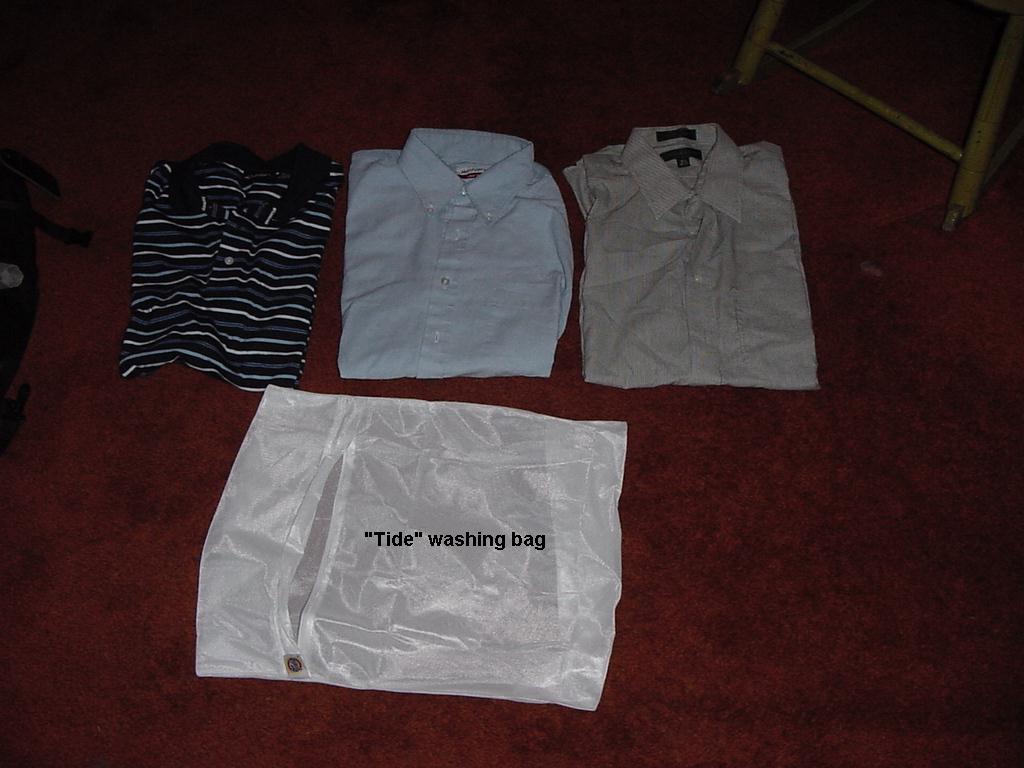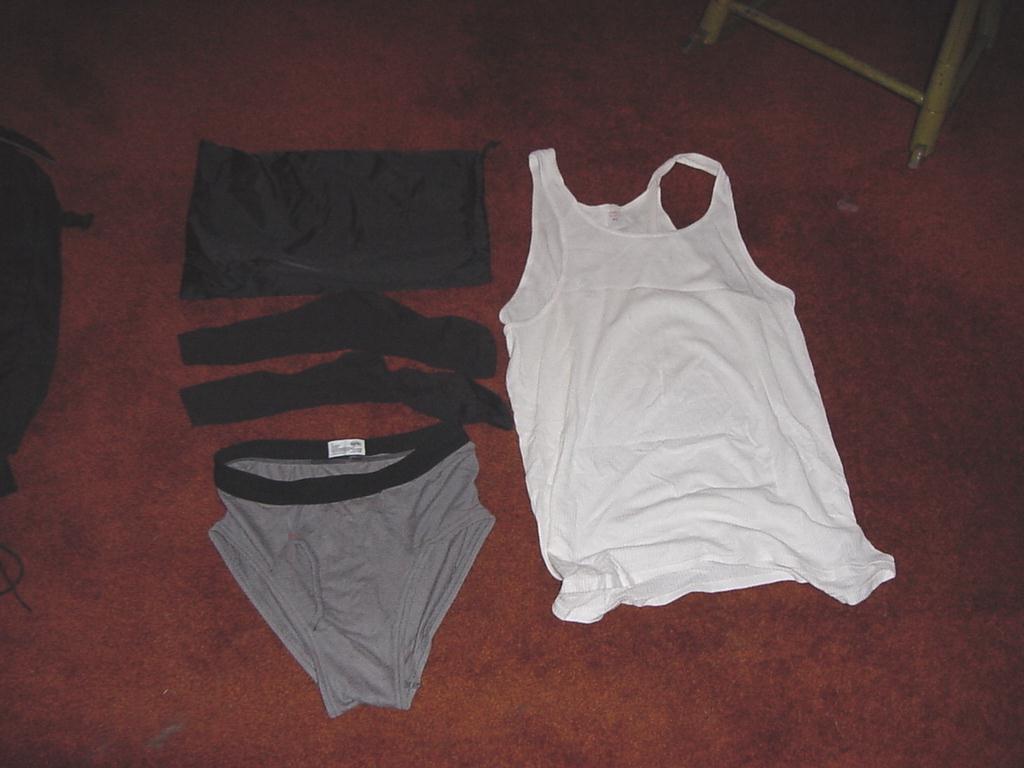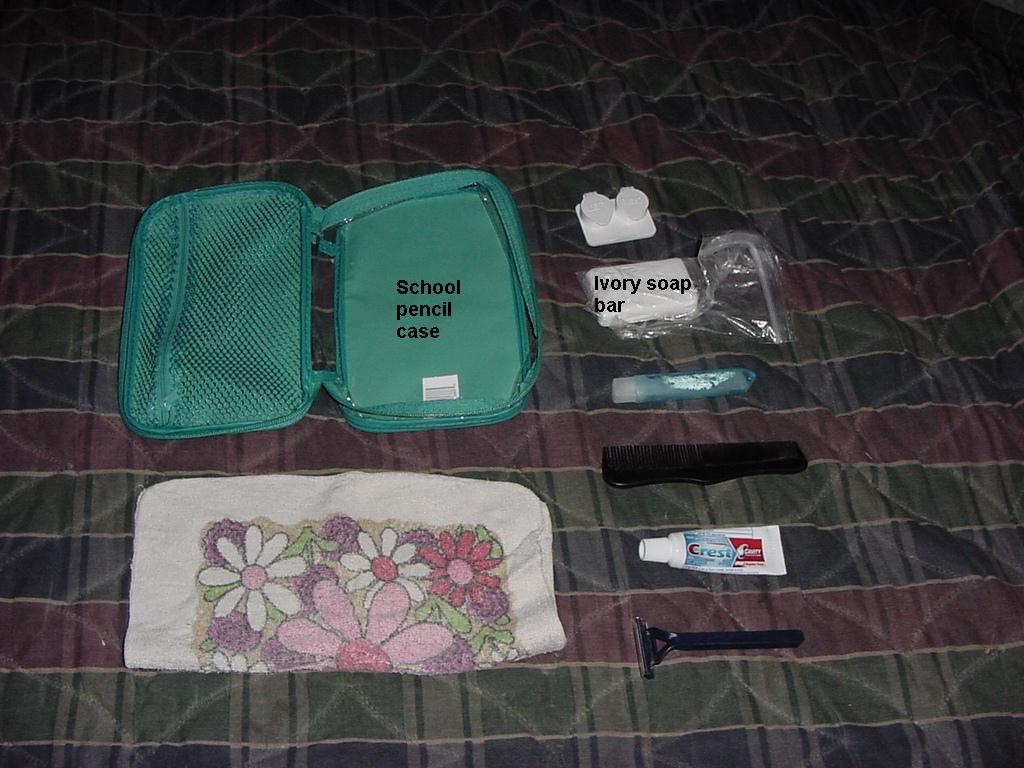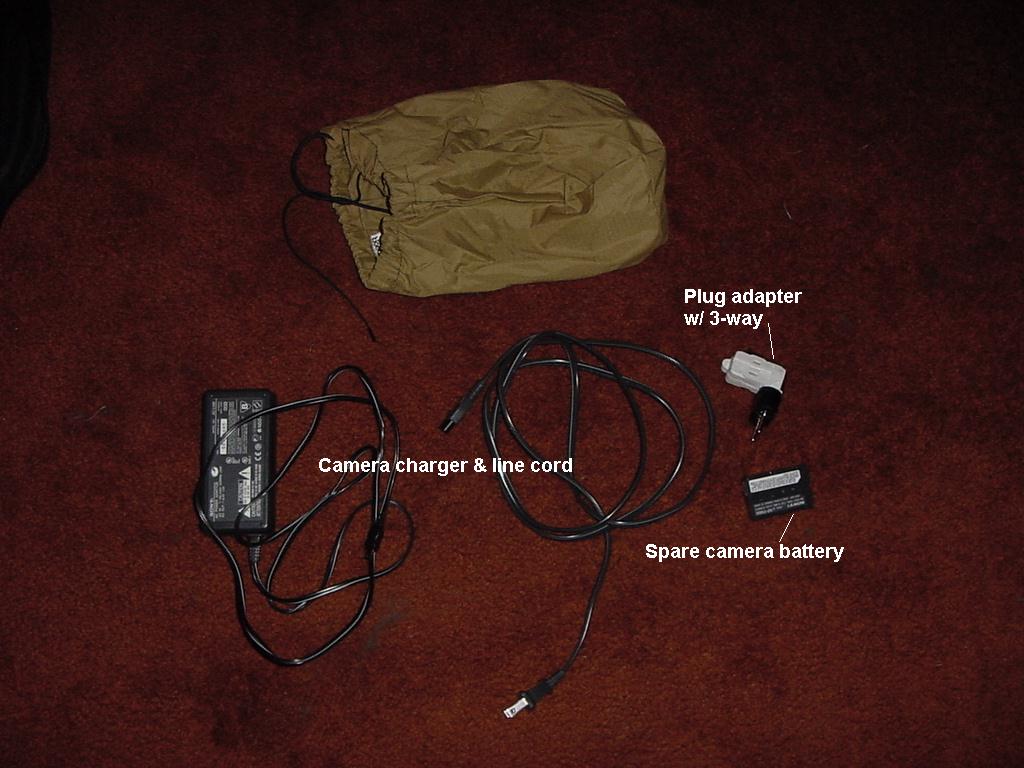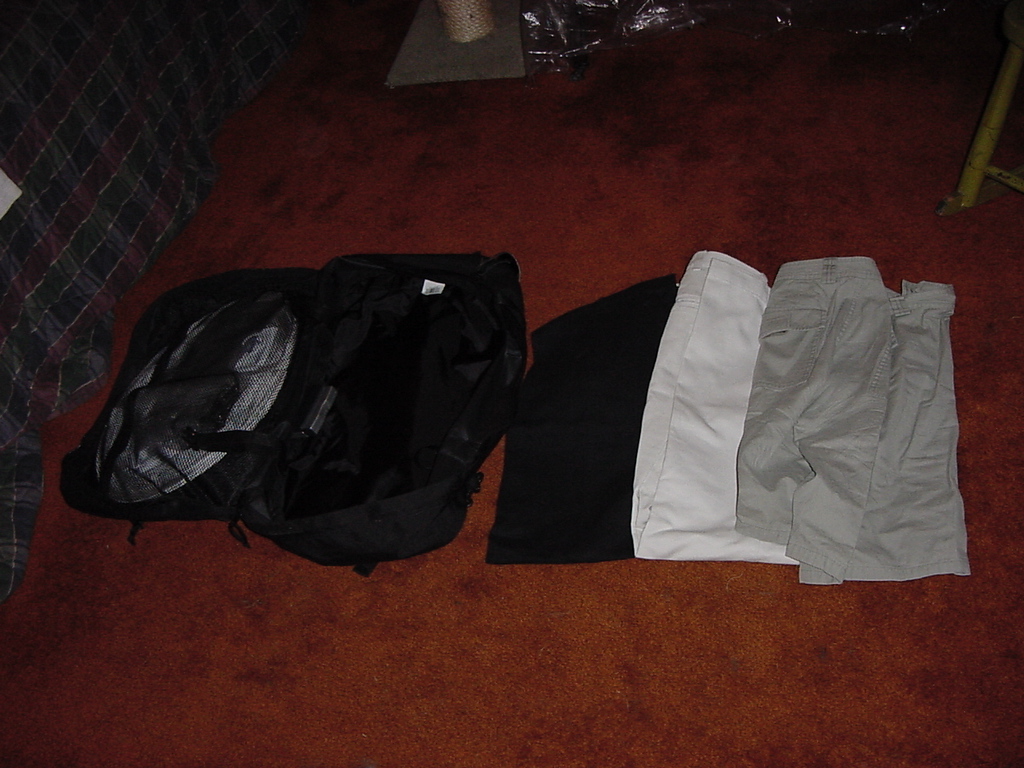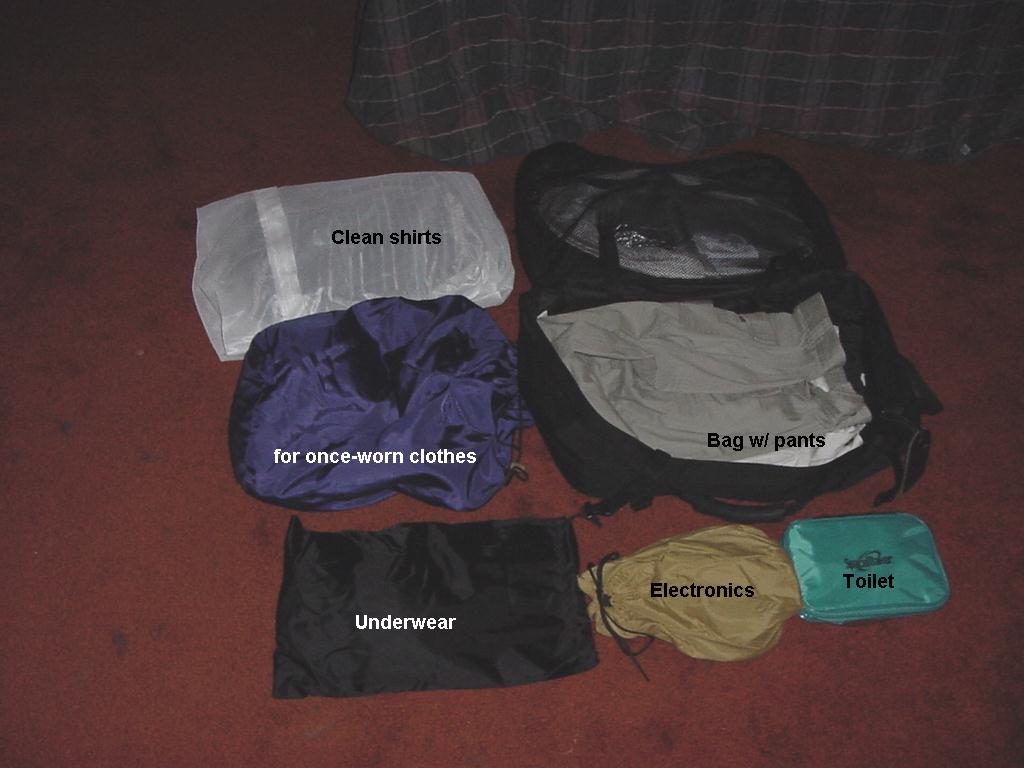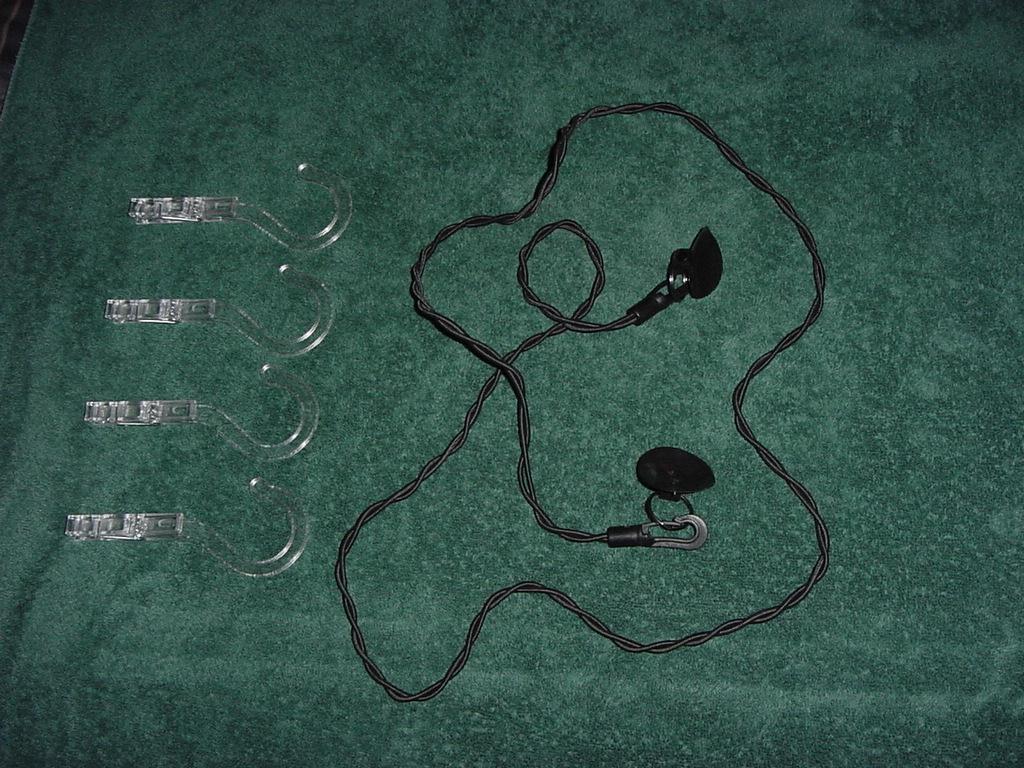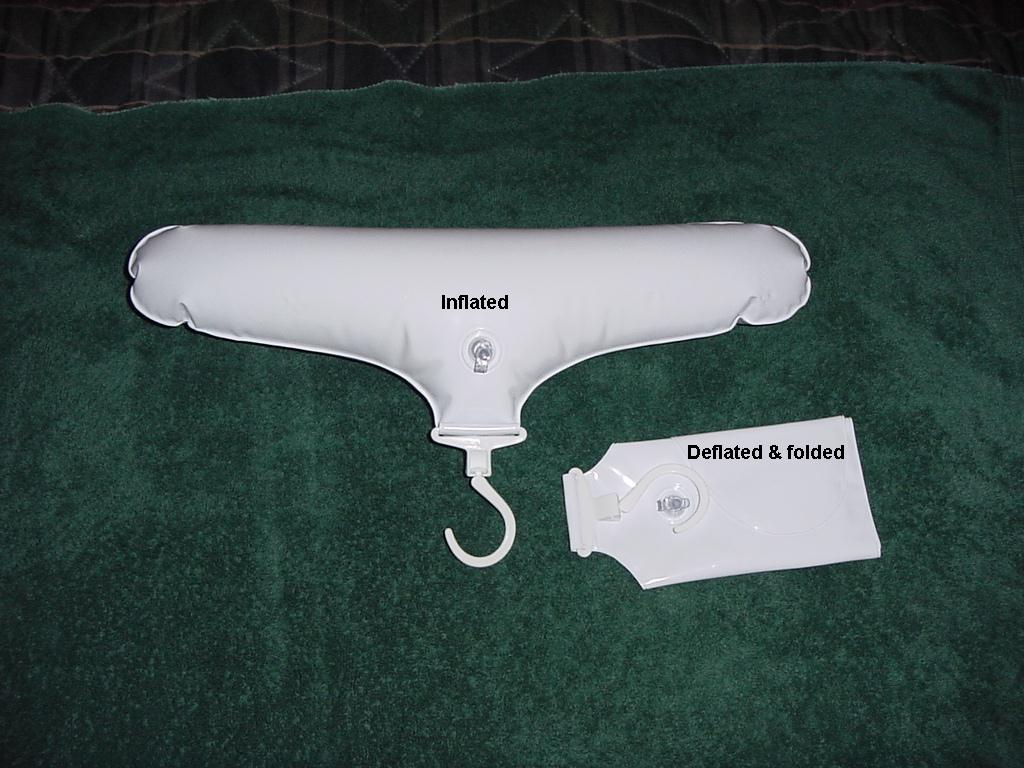I can't emphasize enough the importance of packing light.
- First, you don't want to carry a lot of weight around with you. If you're like most of us, you'll be traveling by train; carrying your bags up and down station stairs, lifting them onto trains, lifting them onto overhead racks.
Even if you have a rental car, there is always the distance from baggage claim to the car rental parking lot. Most likely you won't get to park directly at the hotel, so there is another opportunity to carry your bag. Small hotels often don't have elevators or bellboys. Image carrying that 40# monolyth up narrow hotel stairs.
- Second, you don't want to check your bag. Most European airlines limit you to 8-10 kg (17.6 - 22 lb) of carryon. Yes, you can fly an American flag airline, and they will probably allow you to carry on all you can lift, but you'll have to lift that heavy bag into the overhead rack, and, anyway, who really wants to fly USAir? I don't.
In the last century I had two narrow misses with checked bags. Once, my checked bags almost stayed in the US. Had I not been with someone who was picking up their bags in Boston, and saw my bags on the carousel, they might still be there, going round and round, at Logan. Next trip, on a shuttle flight from Frankfurt to Paris, my bags almost stayed on the plane to Bogata (yeah, South America). Fortunately, a French speaking German couple got the baggage handlers' attention and got them to go out and get our bags off of the plane.
Then, in the late nineties I discovered Rick Steves and read that you can carry on your luggage. I have embraced that policy ever since. It saved my "butt" in 2000, when my flight to an eastern city was delayed by weather. The airline met 13 of us at the gate and took us by van to the waiting international flight, where we made the connection. I don't think any checked luggage could have made the connection, but my carryon was safe in my lap. Five hours after landing in Frankfurt, I was four hours away by train in the Alps. Who knows when my luggage would have caught up to me.
Yeah, it might be "nice" to have that curling iron, but it is weight, and it probably requires a voltage convertor, and that's more weight. The human race has existed for thousands of years, almost all of it without curling irons. If they could do it, so can you.
Last year (2007) I traveled for two weeks in Germany. To save the pound that my rechargeable weighs, I carried instead a disposable razor and shaved with it. OK, I knicked byself a couple of time, but I saved a pound.
Last year (2007) I traveled for two weeks in Germany. To save the pound that my rechargeable weighs, I carried instead a disposable razor and shaved with it. OK, I knicked byself a couple of time, but I saved a pound.
Packing light takes planning.
Don't wait until the night before to decide what to pack. You'll be inclined to bring things you don't really need. Start a packing list now. That way you'll have lots of time to consider how much you really need things.
When you come back, look at the list and say, "What didn't I use?" Edit the list. I've been using (and modifying) the same list for eight years now.
Packing light starts with the bagWhen you come back, look at the list and say, "What didn't I use?" Edit the list. I've been using (and modifying) the same list for eight years now.
Weight: Roll-aboard bags weigh 7-10 lb. That's half the weight limit on some airlines. On Lufthansa, an eight pound roll aboard only leaves you with 9.6 lb of what you want to carry. You don't want half of what you carry to be the bag. My Campmor Carryon Essential Bag weighs 1¾ lb. That gives me almost 16 lb for stuff.
Rigid? Rolling bags usually come with rigid frames. This makes them very inflexable when it comes to fitting into the sizing boxes used by many airlines. As long as it is not overfilled, a flexible, convertible bag, like the Rick Steves or Campmor bag, will flex to fit almost any shape.
Shape: Look at the shape of the bag. If the airline gives you, say, 22"x14"x9", then a rectangular solid of those dimensions gives you the maximum, 2772 in³, of storage. A bag that tapers to 12" wide at the top gives you less capacity. If the bag has an outside pocket of 18"x10"x2" that sticks out to the 9" maximum, then the 22"x14" main compartment can only be 7" deep. That takes away capacity.
Plan to take fewer clothes and wash often.Rigid? Rolling bags usually come with rigid frames. This makes them very inflexable when it comes to fitting into the sizing boxes used by many airlines. As long as it is not overfilled, a flexible, convertible bag, like the Rick Steves or Campmor bag, will flex to fit almost any shape.
Shape: Look at the shape of the bag. If the airline gives you, say, 22"x14"x9", then a rectangular solid of those dimensions gives you the maximum, 2772 in³, of storage. A bag that tapers to 12" wide at the top gives you less capacity. If the bag has an outside pocket of 18"x10"x2" that sticks out to the 9" maximum, then the 22"x14" main compartment can only be 7" deep. That takes away capacity.
In addition to what I wear on the plane (jacket, washable pants, long sleeved shirt, well broken-in walking boots, underwear), I pack
- In my 1¾# carryon bag:
- 2 pr washable pants
- 1 pr short pants (for night and hot weather wear)
- shirts: 2 more long sleeve, 3 cotton/polyester blend golf shirts
- 2 set underwear (shorts and socks)
- Sweater
- toiletrys (wash cloth, soap, toothbrush, toothpaste, razor, contact case and solution)
- hanging clothespins (4), clothesline, inflatable hangers (2)
- bags for clean and for once worn shirts, bag for underwear
- bag with electronics (camera charger, spare battery, plug adapter w/ 3way)
- That's it!
- I also take along a small 8½x11 case with
- 2.2# Netbook computer
- charger, mouse
- misc papers with schedules, addresses
- Rail map
How to keep it all organized.
To keep from having a big mess in my bag, and particularly for unpacking and packing frequently, I organize my things in smaller containers. For the most part, I use nylon "stuff bags" that I picked up at a camping/surplus store. I have a bag for clean shirts, a bag for clean underwear, and a bag for once worn, need to be washed shirts, a bag for my electronics (camera P/S, spare camera battery, and my Europlug with 3way adapter). I fold extra pants once at the knees and put them into the bottom of the bag, along with a lightweight sweater.
This way, when I get somewhere new, unpacking is a breeze. Since virtually every accommodation has a cupboard with shelves, I just take the bags out of the big bag and put them on a shelf. When I need something, I go into just the separate bag to get what I want, and I put things back when I'm through with them. When I'm ready to check out, the separate bags go back in the big bag. With this system, moving ten times in thirteen days is no big deal.
Wash as you go
Pick low-cotton blends which dry quickly. On one of my last trip, I had seven "one-night-stands". I don't recommend anyone do that unless they are already experienced at traveling light. I knew I wouldn't have time for cotton underwear to dry before moving on, so a obtained low-cotton, polyester blend underwear. I took two sets of socks and shorts and wore another set on the plane. When I arrived at each night's accommodation, I changed clothes and washed out the clothes I took off. I rung out ever bit of water I could with the bath mat and set them aside to dry. Washing them in the late afternoon instead of at night gave them more time to dry. I also took along a large zip-loc bag in case they were still moist in the morning, but they were always dry. I actually could have done the trip with just one change of underwear, but an extra set was lightweight insurance.
On my next trip I plan to do the same thing with low cotton T-shirts and "golf shirts". To promote drying I have obtained a set of inflatable hangers. These hangers take up negligible space in my bag and the width when inflated allow space between the front and back of the shirt to promote air circulation.
On my next trip I plan to do the same thing with low cotton T-shirts and "golf shirts". To promote drying I have obtained a set of inflatable hangers. These hangers take up negligible space in my bag and the width when inflated allow space between the front and back of the shirt to promote air circulation.
Should I take a laptop?
That all depends on what kind of laptop and what you do with it. If you have a big, expensive, wide screen laptop, it will be cumbersome and heavy to carry, and a lucrative target for thieves. If you only want it to watch movies and play video games, you paid all this money to see Europe, see it. On the other hand, if you go out of your way to find a small, lightweight notebook, and you use it along with Wifi to stay in contact with home, keep a journal in Word, keep track of expenses with Excel, and download and organize pictures, then it is worth while.
For my first trip this decade, I found that enough memory for my just purchased digital camera would be prohibitively expensive (at 2000 prices), so I took along my 7½# Compaq LTE. I found so many uses for the computer that I never again wanted to travel without one, but by the end of 2 weeks it felt more like 75#.
I came home and found a 2.4# NEC MobilePro on Ebay and used it for 4 trips, but I missed being able to run full Window programs.
A couple of years ago I got a 2.9#, used Toshiba Portege on Ebay and used it for my last trip. That worked nicely, but at only 300MHz, I found it a bit slow. I have since picked up an Acer Aspire One (2.2#, faster, bigger HD, built in Wifi). There are a lot of these Atom processor notebook (like the Acer and the Asus) coming on the market for really low prices. There is no longer any excuse not to take along a notebook.
For my first trip this decade, I found that enough memory for my just purchased digital camera would be prohibitively expensive (at 2000 prices), so I took along my 7½# Compaq LTE. I found so many uses for the computer that I never again wanted to travel without one, but by the end of 2 weeks it felt more like 75#.
I came home and found a 2.4# NEC MobilePro on Ebay and used it for 4 trips, but I missed being able to run full Window programs.
A couple of years ago I got a 2.9#, used Toshiba Portege on Ebay and used it for my last trip. That worked nicely, but at only 300MHz, I found it a bit slow. I have since picked up an Acer Aspire One (2.2#, faster, bigger HD, built in Wifi). There are a lot of these Atom processor notebook (like the Acer and the Asus) coming on the market for really low prices. There is no longer any excuse not to take along a notebook.
